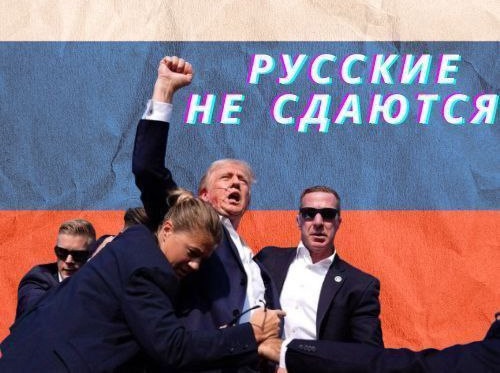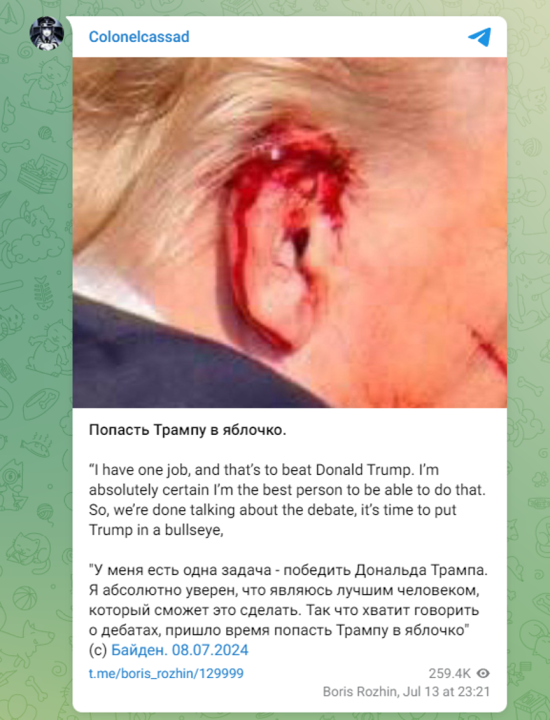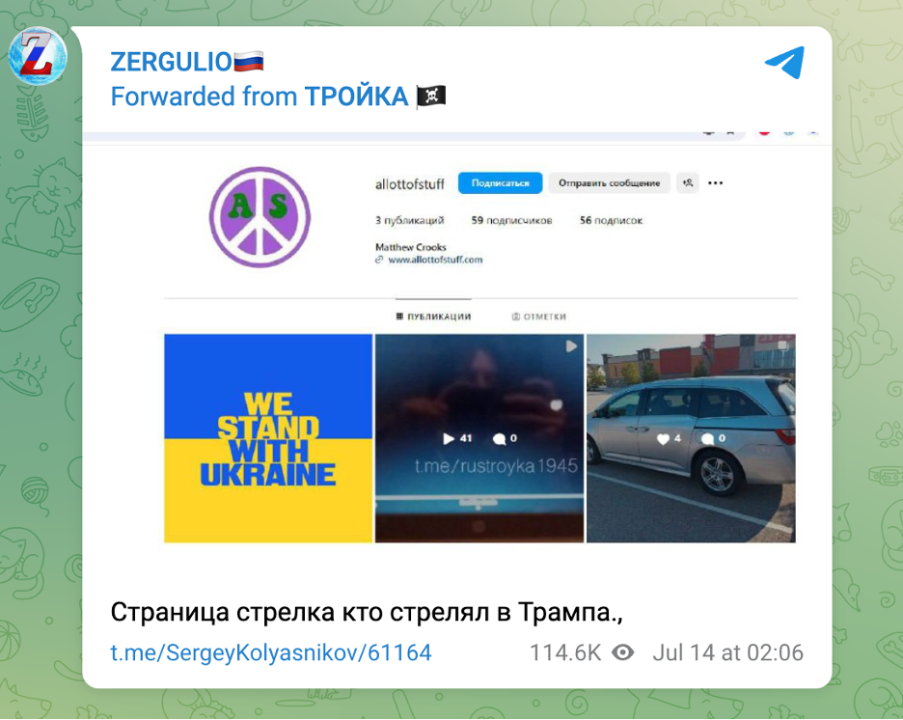How Russian propagandists spun the Trump assassination attempt
Conspiracy theories, alarmism, and early attempts to link the shooting with Ukraine
How Russian propagandists spun the Trump assassination attempt
Share this story

Banner: Russian meme showing former president Trump in front of a Russian flag with the slogan, “Russians don’t give up.” (Source: Chelovek iz okon/archive)
It was 1:11am Moscow Time when a twenty-year-old gunman in Butler, Pennsylvania made his attempt on former President Trump’s life. The late hour did little to stem the enthusiasm of pro-Kremlin propagandists, influencers, and apparatchiks. By the time most Russians awoke, they were greeted with a sea of reporting and commentary that blended American conspiratorialism with distinctly Russian aims and interests.
These early narratives provide a compelling glimpse of the Russian media ecosystem in action. They also suggest how and where Russian influence efforts may be focused in the weeks ahead.
High-level official Russian sources were quick to engage with and amplify the hyper-partisan speculation that swept US social media alongside news of the assassination attempt. On Telegram, the ecosystem of Kremlin-adjacent personas and military bloggers took things a step further, engaging with wild American speculation as to the preparation and motivation of the would-be assassin and seeking to tie the plot to continuing US support for Ukraine.
Although this coverage was not monolithic, it pivoted on a few key themes. These were the purportedly dangerous rhetoric of President Biden; complicity or conspiracy by the US Secret Service (due, some claimed, to the existence of a global US assassination plot); and the imminence of a second American civil war. In some cases, Russian influencers struggled to balance their sympathy for Trump with their more general disdain for the United States. In general, these pro-Russian voices sought to tie the assassination attempt with Russia’s continuing war against Ukraine.
At the time of publishing, the DFRLab had not identified any large-scale malign influence campaigns from pro-Russian actors seeking to capitalize on this event. This is unsurprising. In many cases, such directed information manipulation efforts exploiting breaking news events take root after global attention has drifted away. The DFRLab also identified few instances in which Russian actors sought to manufacture truly novel narratives. Given the volume and intensity of speculation on US social media, there was little need.
Official Russian sources open the door to conspiratorialism
Among the first Kremlin officials to comment on the attempted assassination was Kremlin spokesperson Dmitry Peskov. In his remarks, which were amplified across pro-Kremlin media, Peskov accused the Biden administration of creating an atmosphere that led to the attack. “We do not believe that the attempt to eliminate and assassinate Trump was organized by the current authorities,” he said. “But the atmosphere around candidate Trump … provoked what America is confronting today.”
Having distanced himself from the idea that the plot had been a US government conspiracy, Peskov insinuated that it may in fact have been a US government conspiracy. “After numerous attempts to remove candidate Trump from the political arena, using first legal tools, the courts, prosecutors, attempts to politically discredit and compromise the candidate, it was obvious to all outside observers that his life was in danger,” he added.
Shortly afterward, Russian Foreign Ministry spokesperson Maria Zakharova took to Telegram and mused to her nearly 500,000 subscribers about the 1968 assassination of US presidential candidate Robert F. Kennedy and the security failings that appeared to link both cases. She suggested that this was the almost inevitable outcome of US aid for Ukraine, as terrorism had returned to American shores from this “machine of murder.”

Russian political commentator Igor Dimitriev, former deputy of the Odessa City Council, stated that US political rhetoric played into the hands of a lone-wolf shooter looking for an opportunity to make a name for himself. “I am far from thinking that malicious intelligence agencies are devising operations to eliminate recalcitrant leaders of countries,” he wrote. “No, I suppose it doesn’t work that way. It’s just that the media and political pundits create a situation where the loonies get excited, stay up nights, and dream of ridding the world of a particular dictator. Some of the lunatics will find a gun and decide to commit a murder, for which they have received moral credit from the rulers of their minds.”
The speculation of other semi-official Russian sources blurred the line between irresponsible rhetoric and conspiracy. “The Butler shooting is a direct consequence of years of dehumanization of the Republican by his Democratic opponents,” commented Valentin Bogdanov, New York bureau chief of the All-Russia State Television and Radio Broadcasting Company (VGTRK). “Biden’s entire campaign (so far) has been built on the idea that Trump is an absolute evil who cannot be allowed into the White House at any cost. Sooner or later, there was going to be someone who thought that any price was Trump’s life. There had to be. And they did.”
Pul N3, a popular Russian Telegram channel administered by Komsomolskaya Pravda’s Dmitry Smirnov, shared a video of former US Speaker of the House Newt Gingrich discussing the assassination attempt. “[Trump] has been vilified by Joe Biden, the Democrats and the left wing more than any president since Abraham Lincoln,” he translated Gingrich as saying. “And it was a political act. This was a deliberate act.”
Down the rabbit hole
The wider network of pro-Russian Telegram channels engaged with conspiracy theories circulating on US social media, adding their own permutations and peppering their analysis with anti-Ukrainian commentary. Other pro-Kremlin voices pondered the sheer volume and intensity of American discourse on the subject, some going so far as to suggest that it presaged a second American Civil War.
Colonelcassad, a popular military blogger on Telegram with more than 860,000 subscribers, highlighted remarks by President Biden from a July 8 fundraiser in which he stated, “I have one job, and that’s to beat Donald Trump. I’m absolutely certain I’m the best person to be able to do that. So, we’re done talking about the debate, it’s time to put Trump in a bullseye.” Because Colonelcassad appended to this quote to a zoomed-in photo of Trump’s bloodied face, the implication was clear.

MIG Rossiya, an influential, pro-Russian military Telegram channel with more than 460,000 subscribers, juxtaposed photos of the 1963 assassination of President John F. Kennedy with photos of the bullet in flight that had nearly killed former President Trump. It included the caption, “Two photos that have already gone down in history.” Telegram subscribers were left to ponder the deep web of conspiracy theories that still lingers around the Kennedy assassination, even as a new generation of such theories was being given form.

In another post, Troika, a pro-Russian channel with nearly 220,000 subscribers, shared a screenshot of an Instagram page allegedly belonging to the gunman, which included the images of the Ukrainian flag and an English-language caption: “WE STAND WITH UKRAINE.” The image was a low-effort forgery, one of numerous misleading photos and social media profiles which proliferated across the internet in the hours before the assassin was formally identified by law enforcement officials. This did not prevent it from spreading far on Russian-language Telegram, to even bigger channels.
Some of the most prominent English-language commentary by Russia-adjacent actors sought to tie the attempted Trump assassination to the May 2024 assassination attempt on Slovakian Prime Minister Robert Fico. That incident sparked a firestorm of conspiracy theories about the complicity of the West and “dirty media” in the violence, egged on by Russian media (Fico is widely perceived as pro-Russian and Euroskeptic).
As news of the attempt on Trump’s life spread, so did comparisons with events in Slovakia. The most prominent figure to draw such a parallel was Fico himself, who penned a Slovak-language Facebook note in which he declared that the attempted Trump assassination had followed a familiar script. He blamed Trump’s political opponents, alleging that they had sought to “piss the public off so much that some loser picks up a gun.”
Aussie Cossack, a pro-Russian propagandist with more than 60,000 followers on X, suggested that this was all part of a plot to assassinate populist leaders that were seeking to prevent WWIII, and warned that Hungarian Prime Minister Orban would be next. Aussie Cossack is operated by Simeon Boikov, an Australian citizen who routinely spreads viral falsehoods and who was granted Russian citizenship last year after taking refuge in Sydney’s Russian consulate in order to avoid assault charges by local police.

Other Russian observers took more interest in the general conspiratorialism of US audiences rather than advancing a particular theory of their own. Kotsnews, a Telegram channel with nearly 570,000 subscribers operated by Alexander Kots, well-known Russian propagandist and contributor to Komsomolskaya Pravda, poked fun at Americans for “drowning in conspiracy theories” while still insinuating that the attack may have been centrally planned.
A more cerebral perspective came from Russian writer and cultural critic Platon Besedin. “The reaction to the Trump shooting is telling,” he wrote to his 11,000 Telegram subscribers. “It seems that objective truth-seeking is finally a thing of the past. People write and broadcast exclusively what fits their perception paradigm. A step to the right, a step to the left is a firing squad. So each camp will stick to the strictly canonical version: damned deep state / Trump set it all up himself.” Besedin also took the opportunity to promote one of his recent YouTube videos—a critical reflection on the 2024 Hollywood film Civil War, which imagines future civil conflict and dystopia in the United States.
Indeed, the prospect of an American civil war was raised regularly in Russian commentary. Vyacheslav Volodin, speaker of Russia’s lower house of the Duma, shared a blunt assessment with his nearly 1.2 million Telegram subscribers: “With its years-long policy, the United States has let itself reach literally the brink of civil war.” He claimed that a recent “sociological survey” had determined a 37 percent chance of a US civil war in the event of a Biden re-election.
Russia-24 war correspondent Yevgeny Poddubny made similar claims to his more than 700,000 subscribers, stating that the attempted assassination of Trump could “collapse the States into the abyss of civil war.” WTF Moldova?!, one of a network of anonymously operated and highly visible Telegram channels which floods the Moldovan information environment with pro-Russian content, echoed this sentiment. “If the shooter hit, then a civil war in the States would have been almost inevitable,” a channel operator wrote to their nearly 10,000 subscribers. “We live in very interesting times.”
Solidarity and bitterness
Some corners of pro-Russian Telegram expressed solidarity and sympathy with Trump. Just sixty minutes after the attempted assassination, the extremely popularmilblogger channel Operation Z circulated an unusual image to its 1.5 million subscribers. It was a photo of a 152mm howitzer shell, purportedly taken from Russian frontlines at the Ukrainian town of Chasov Yar. On it was scrawled a message: “For Trump’s Ear.” It took just thirty-four more minutes for X influencer Aussie Cossack to translate and share this and other similar artillery shell missives with his audience. For Americans following events on the platform formerly known as Twitter, this was likely among the first Russian-language messages that they would have seen.

Across several pro-Russian military channels, especially those associated with the Wagner private military company, one could find a defiant photo of Trump in the immediate aftermath of the assassination superimposed against a Russian flag with the words, “Russians don’t give up.” The more general news and commentary-focused Pul N3 channel (more than 340,000 subscribers) shared a backhanded meme that expressed sympathy for Trump even as it condemned the United States. It featured Trump in a lineup of other assassinated US presidents, crosshairs over his face. “True Democracy,” the caption read.

Yet expressions of support for Trump were also accompanied by bitterness, especially by those closely tracking the Russian war effort. On Telegram, milblogger Andrey Medvedev cautioned his 185,000 subscribers that this news should not distract them from their focus on Ukraine, and that either a new Biden or Trump presidency would likely give aid to Ukraine.
There was also fear. Russia-24 milblogger Yevgeny Poddubny reminded his 700,000 subscribers that an American civil war would benefit neither Russia or China, because the United States was a nuclear power and no one could predict who might end up in charge of the “red button.” Daniil Beznosov, deputy information minister of the Russia-controlled Donetsk People’s Republic, struck a cautionary tone with his roughly 320,000 subscribers. “This assassination attempt suggests that those who now rule the Western world are maniacs gone crazy,” he said. “If they are prepared to kill their own presidents, then why wouldn’t they be capable of starting a nuclear war? This is necessary and important to think about.” Beznosov’s message was forwarded across Telegram’s Wagner ecosystem.
Wagner channels also found dark humor in the news. They cited the Russian law that entitles wounded Russian soldiers to three million rubles. Some joked that he was unlucky to have been wounded outside the territory of Russia’s so-called “special military operation” in Ukraine, because he would not be eligible. Others—sharing memes and altered images—claimed that he would be eligible after all.

Opportunism ahead
In June 2024, the Washington Post reported on leaked Kremlin documents that revealed an extensive Russian operation to interfere in the outcome of the European parliamentary elections. At the center of this effort was Viktor Medvedchuk, who presents himself as a “Ukrainian opposition figure” but who serves as a Russian puppet. Medvedchuk had helped lead an effort to raise the profile of European politicians opposed to Ukrainian aid and to present himself as the leader of a viable government in exile.
Shortly after the attempt on Trump’s life, Medvedchuk appears to have turned his attention to the United States. On July 16, the Russian propaganda agency TASS published an English-language story about a letter sent to Trump by Viktor Medvedchuk, In the letter, he claimed that Trump’s stated intent to seek an end to the conflict had enraged both the “Nazi regime” of Ukrainian President Volodomyr Zelenskyy and “his American sponsors from the Biden administration.” Medvedchuk continued, “I think that a Ukrainian link may appear in the assassination attempt case.”
On pro-Russian Telegram, at least, the first specious links between Ukraine and the attempted Trump assassination have already been drawn.
Cite this case study:
Emerson T. Brooking, Eto Buziashvili, Andy Carvin and Ruslan Trad, “How Russian propagandists spun the Trump assassination attempt,” Digital Forensic Research Lab (DFRLab), July 18, 2024, https://dfrlab.org/2024/07/18/russian-propaganda-trump-shooting/.



